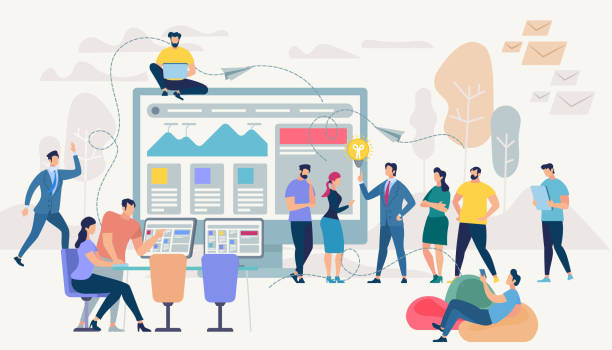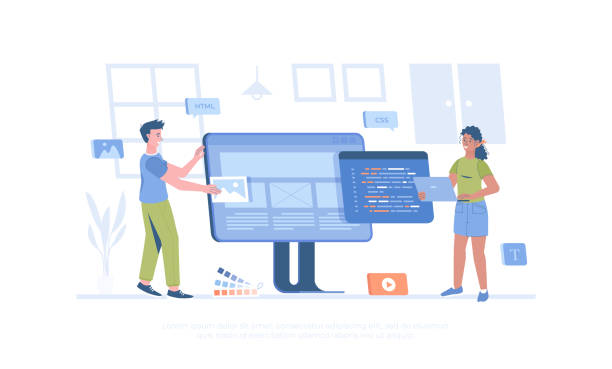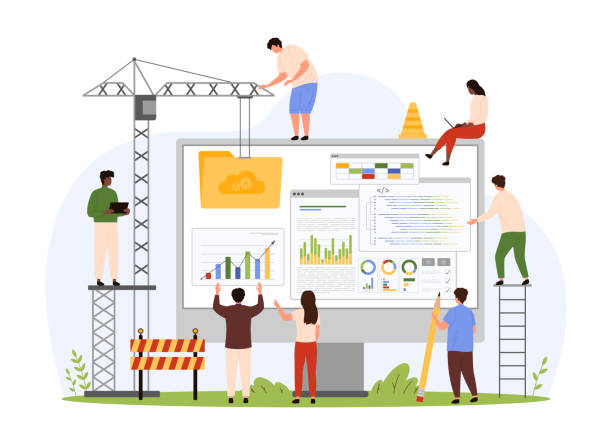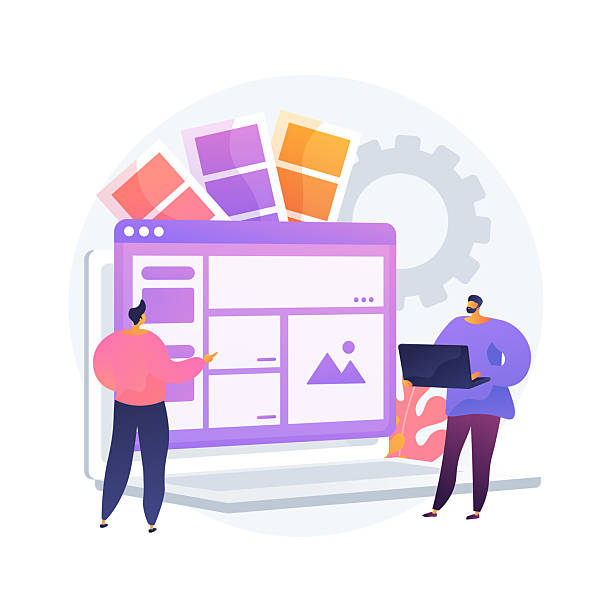The Importance of E-commerce Website Design in the Digital Age

In today’s fast-paced world, where #technology and the #internet have become an integral part of daily life, an online presence is not just an advantage for any business, but an undeniable necessity.
E-commerce website design is no longer merely an option; it’s the backbone of growth strategy for many companies, from small startups to large brands.
This digital transformation has provided an unparalleled opportunity to reach customers beyond geographical and time constraints.
An online store allows businesses to showcase their products and services 24 hours a day, seven days a week, which leads to a significant increase in sales and revenue.
The benefits of having an e-commerce website extend far beyond mere sales; it’s a strategic investment for survival and growth in today’s competitive market.
An online store acts as a powerful #branding tool, allowing businesses to convey their visual identity, values, and message in a unified manner to a broader audience.
Through proper e-commerce website design, you can tell your brand’s story and establish deeper connections with customers.
Furthermore, the ability to collect customer data and analyze purchasing patterns provides valuable information for optimizing marketing strategies, personalizing experiences, and predicting future trends.
This analytical approach enables your business to better understand customer needs and significantly increase conversion rates by offering targeted suggestions.
Reduced operational costs compared to physical stores, access to new international markets without the need for heavy physical investments, and establishing a direct and sustainable relationship with customers are just some of these benefits.
In fact, any business aspiring for long-term growth and sustainability must make a serious investment in professional and efficient e-commerce website design.
This approach not only boosts sales but also gains customer trust and ensures their loyalty.
The importance of this issue is such that a lack of online presence can mean losing a large market share and falling behind competitors.
Therefore, to succeed in today’s competitive landscape, e-commerce website design is the fundamental and crucial first step that opens a window to endless opportunities in the digital world and allows businesses to have a global presence.
Dissatisfied with your e-commerce website’s low sales?
Rasaweb is your solution for a professional and high-selling e-commerce website.
✅ Significant increase in sales and revenue
✅ Easy and enjoyable shopping experience for customers
⚡ Get a free consultation from Rasaweb now!
Essential Features of an Ideal E-commerce Website

For an #e_commerce_website to achieve its goals of attracting customers and increasing sales, it must possess key and vital features that not only enhance the user experience but also contribute to the efficiency and success of the business in the online space.
The first and most important feature is a strong User Interface (UI) and User Experience (UX).
A website must be visually appealing, easy to navigate, and completely user-friendly.
Customers should be able to easily find their desired products, view their details, and complete the purchasing process without any complexity or confusion.
Clean visual design, appropriate color usage, and clear Call-to-Action (CTA) buttons all contribute to this.
The second vital feature is Mobile Responsiveness.
Given the increasing use of mobile devices for online shopping and the #importance_of_mobile_SEO in Google rankings, your e-commerce website must be fully compatible with various screen sizes and resolutions, from smartphones to tablets.
This not only helps improve the user experience but also impacts your site’s SEO ranking.
Website loading speed is also of high importance.
Today’s #users expect pages to open quickly; even a few seconds of delay can lead to site abandonment and lost customers.
Image optimization, code compression, caching, and choosing suitable hosting are among the solutions for increasing speed.
Additionally, clear and high-quality product display, including multi-angle images, product videos, and comprehensive and precise descriptions, is essential to gain customer trust and aid their decision-making.
Integrating secure and diverse payment methods, providing customer support options (such as online chat, comprehensive FAQs, and phone contact), and the ability for customers to review and rate products are all key components of a successful e-commerce website that help increase trust and transparency.
Ultimately, e-commerce website design should be #scalable, allowing it to grow with the business without requiring a complete and costly redesign, and capable of handling increased traffic and order volumes.
These features combined will ensure an enjoyable and efficient shopping experience for the customer and a significant return on investment for the business, laying the foundation for a sustainable online store.
Choosing the Right Platform for Your E-commerce Website Design

One of the most crucial decisions in the #ecommerce_website_design journey is choosing the right platform.
This choice directly impacts the #costs, #features, #scalability, and #ease_of_management of your online store in the long run.
Numerous options are available in the market, each with its own advantages and disadvantages.
A thorough understanding of these platforms and matching them with your specific business needs is a vital step that determines the success or failure of your project.
WooCommerce is a powerful and highly popular plugin for WordPress that allows you to create a fully functional e-commerce website on an existing WordPress site.
Its main advantages are high flexibility, countless themes and plugins, and the free basic software.
This platform gives you complete control over your data and is suitable for deep customizations.
However, it requires more technical knowledge for setup and management and involves costs related to hosting, security, and premium plugins.
Shopify is a SaaS (Software as a Service) platform known for its ease of use, quick setup, and offering a comprehensive solution without the need to deal with technical issues (such as hosting and security).
Shopify is ideal for small and medium-sized businesses looking for a comprehensive and hassle-free solution.
All technical aspects like hosting, security, and updates are managed by Shopify, but in return, it offers less flexibility for deep customization and involves fixed monthly fees and transaction charges.
Magento is an open-source platform designed for large businesses with complex needs and high product and traffic volumes.
This platform offers unparalleled customization capabilities and can manage high volumes of traffic and products.
However, it requires very high technical knowledge, significant development and maintenance costs, and is not suitable for beginners or small businesses.
In addition to these, custom e-commerce website design is another option that gives you complete control over all aspects of the site, from design to performance.
This method is suitable for businesses with very specific needs, high budgets, and an in-house technical team, but it is the most time-consuming and costly option.
The choice of platform should be based on your budget, business size, existing technical knowledge, and future needs, so that your e-commerce website is designed and implemented in the best possible way.
Ultimately, consulting with e-commerce website design specialists and a precise analysis of needs can assist you in this important choice and prevent additional costs in the future.
| Platform | Advantages | Disadvantages | Suitable for |
|---|---|---|---|
| WooCommerce | High flexibility, thousands of plugins and themes, full data control, large user community | Requires more technical knowledge, hosting and premium plugin costs, security responsibility is yours | Small to medium businesses needing customization, developers |
| Shopify | Easy to use, quick setup, excellent support, manages all technical aspects | Less flexibility in customization, fixed monthly fees, platform dependency | Small and medium businesses without extensive technical knowledge, dropshipping |
| Magento | Powerful, scalable, highly customizable, suitable for large businesses | Complex, expensive, requires very high technical knowledge and a professional development team | Large and enterprise businesses with complex needs and high budgets |
| Custom Design | Full control, infinite customization, high security, no platform dependency | Very time-consuming and expensive, requires in-house or outsourced expert development team | Businesses with very specific needs, high budgets, and a long-term vision |
The Role of User Interface and User Experience in the Success of an Online Store

In the age of #e_commerce, the success of an online store depends not only on product quality or competitive pricing but also heavily on its #User_Interface (UI) and #User_Experience (UX).
These two concepts, although often confused, are complementary and play a vital role in a customer’s purchasing decision.
UI refers to the site’s appearance and visual elements (such as buttons, colors, fonts, icons) and focuses on aesthetics and clarity, while UX pertains to the customer’s overall feeling when using the site, the ease of completing tasks, and their ultimate satisfaction.
A poor UI/UX design can lead to high shopping cart abandonment rates, reduced visits, and lost customers.
Navigation complexity, long loading times, or confusing payment processes directly negatively impact conversion rates.
In contrast, a good design provides an enjoyable and hassle-free experience for the user.
This includes easy and intuitive navigation that allows customers to quickly find their desired products, efficient search filters, clear product descriptions, and high-quality, multi-view images.
Furthermore, the payment process should be simple, step-by-step, and without complexity; even offering a guest checkout option can significantly increase conversion rates.
Every step from product selection to purchase completion must be designed to create the least resistance and friction for the user.
Furthermore, #personalizing the shopping experience is also of high importance.
By utilizing user data and artificial intelligence, relevant product suggestions (such as “Customers who bought this also liked these products”), customized content, and special discounts can be offered, which significantly increases conversion rates and instills a sense of value in the customer.
Customer reviews, frequently asked questions (FAQ), and online chat options also help improve user experience and build customer trust.
The importance of e-commerce website design with a focus on UI/UX cannot be overlooked, as these two factors directly impact #conversion_rates and customer loyalty.
In fact, investing in user-centric design is an investment in the future of your business.
Attention to small but important details, including page loading times, responsiveness across different devices, and appropriate feedback to user actions, can make a significant difference in the ultimate success of your e-commerce website and transform it into a desirable online shopping destination.
Tired of your e-commerce website not generating income to its full potential? Rasaweb, a specialist in professional e-commerce website design, solves this problem permanently!
✅ Increased sales rate and revenue
✅ High loading speed and unparalleled user experience
⚡ Get a free e-commerce website design consultation
Search Engine Optimization (SEO) for E-commerce Websites

For an #e_commerce_website to be seen among thousands of competitors and attract significant traffic, a beautiful design alone is not enough.
Search Engine Optimization (SEO), especially for #online_stores, is a vital element for attracting organic traffic and increasing sales.
Without a strong SEO strategy, even the best products might go unnoticed in the web world and get buried deep in search results.
The primary goal of SEO is to help your site achieve a higher ranking in Search Engine Results Pages (SERP) for keywords related to your products, putting it in front of potential customers.
The first step in #e_commerce_SEO is accurate and comprehensive #keyword_research.
Identifying the words your potential customers search for on Google to find your products is crucial.
These keywords should not only be used in product titles, descriptions, meta descriptions, and even page URLs, but also be naturally and sparingly integrated into the text.
Intelligent use of long-tail keywords, which are less competitive and more targeted, can also drive more qualified traffic to your site and result in higher conversion rates.
#On_Page_SEO involves optimizing internal elements of the site’s pages.
This includes writing unique and comprehensive product descriptions, using heading tags (H1, H2, H3) hierarchically, optimizing images (using appropriate Alt tags and compression for speed), and ensuring a proper and readable URL structure.
E-commerce website design should also be technically optimized.
This means high loading speed (which directly impacts user experience and ranking), full mobile responsiveness (Google’s Mobile-First Indexing), a logical URL structure, using an XML sitemap to aid search engine crawling, and a correct Robots.txt file to control bot access.
Creating high-quality and relevant content, such as blog articles about products, buying guides, or product comparisons, not only helps attract traffic through search but also adds to your site’s credibility and authority in the eyes of search engines.
Additionally, #Link_Building by acquiring high-quality backlinks from reputable and relevant sites helps increase your domain authority.
You should continuously monitor your site’s SEO performance with tools like Google Analytics and Google Search Console to identify potential issues and discover opportunities for improvement.
A successful e-commerce website design always views SEO as an inseparable part of its development and maintenance process, considering it not an expense, but a long-term investment for visibility and customer acquisition.
Security and Payment Gateways in E-commerce Website Design

One of the most significant concerns for any #online_shopper is the #security of their personal and financial information.
For an e-commerce website, building customer trust is crucial, and this trust will never be achieved without fully adhering to #security_standards and providing #reliable_payment_gateways.
Any security breach not only causes irreparable damage to your business’s reputation but can also lead to severe legal consequences and result in losing customers and market share.
Therefore, in the process of e-commerce website design, security must be given absolute priority and special attention from the very initial stages.
The first step and one of the most fundamental requirements in ensuring security is the use of an SSL (Secure Sockets Layer) certificate.
This certificate encrypts all information exchanged between the user and the server, and its presence is indicated by a lock icon and “https” in the browser’s address bar.
This is not only essential for gaining user trust and ensuring the confidentiality of their information but also a significant factor in Google’s SEO ranking.
In addition to SSL, adherence to #PCI_DSS (Payment Card Industry Data Security Standard) security standards is mandatory for any site that processes credit card information.
These standards define a set of strict security requirements for protecting payment data, and non-compliance can lead to heavy penalties and the loss of credit card processing capabilities.
Choosing the right payment gateway is also of high importance.
Payment gateways are secure and essential intermediaries between your e-commerce website and banks or payment companies that facilitate the payment process in an encrypted and secure manner.
In Iran, there are numerous payment gateways, including Zarinpal, NextPay, Saman, and Pasargad, each offering different services and fees.
To select the best option, factors such as the security and credibility of the gateway, ease of use for the customer, and the quality of its technical support should be considered.
Furthermore, offering diverse payment options (such as card-to-card, installment payments, or cash on delivery for specific products) can improve the shopping experience for customers and increase conversion rates.
E-commerce website design should be such that all these security layers function seamlessly without disrupting the user experience, allowing customers to shop with peace of mind and trust your business.
Continuous #security_audits and software updates are also necessary to combat new cyber threats.
Marketing and Advertising Strategies After Launching an E-commerce Website

After completing e-commerce website design and launching it, the real work truly begins.
For your online store to succeed and achieve high sales, you need a strong and continuous #marketing and #advertising strategy.
Even the best e-commerce website design will not yield results without visibility and customer acquisition.
The goal is to attract potential customers, convert them into buyers, and then into loyal customers who repeatedly purchase from you.
One of the most effective methods is #content_marketing.
By producing valuable and relevant content related to your products, such as blog articles on how to use products, comprehensive buying guides, educational videos, infographics, and case studies, you can attract organic traffic and enhance your brand’s credibility as a reliable source in your field.
#Social_media_marketing is also a powerful tool.
An active presence on platforms like Instagram, Telegram, LinkedIn, and even TikTok (depending on your products and audience) can help you interact with your customers, introduce new products, showcase behind-the-scenes of your business, and run engaging advertising campaigns.
Using #Paid_Ads like Google Ads (for search and display) and social media advertising (such as Instagram Ads and Facebook Ads) can help you quickly reach targeted audiences and increase your sales.
These methods allow precise audience targeting based on age, interests, location, online behavior, and even demographics.
#Email_marketing also remains one of the most effective methods for maintaining customer relationships and encouraging repeat purchases.
By collecting email addresses (with user permission), you can send newsletters, special offers, discount codes, and notifications about new products to them, establishing personalized communication.
#Customer_loyalty programs, offering special discounts and gifts for frequent buyers, and organizing engaging contests and campaigns help build deeper customer relationships and increase their loyalty.
#Influencer_marketing can also help increase brand awareness and attract new customers by collaborating with influential individuals in your field.
Ultimately, e-commerce website design and marketing strategy must work in an integrated manner to bring the best results for your business and create a sustainable growth cycle.
This comprehensive approach will guarantee the long-term success of your online store and differentiate it from its competitors.
| Strategy | Description | Benefits |
|---|---|---|
| Content Marketing | Producing and publishing valuable content (blog, video, infographic) related to products | Attracting organic traffic, increasing brand credibility, improving SEO |
| Social Media Marketing | Active presence on social platforms to interact with customers and introduce products | Increasing brand awareness, direct customer communication, referral traffic |
| PPC Advertising (Pay-Per-Click) | Using platforms like Google Ads and social media advertising to attract targeted traffic | Quick access to target audience, immediate sales increase, precise budget control |
| Email Marketing | Collecting customer emails and sending newsletters, special offers, and announcements | Maintaining customer relationships, increasing repeat sales, high ROI |
| Loyalty Programs | Offering discounts, points, and special gifts to regular customers | Increasing customer loyalty, encouraging repeat purchases, word-of-mouth advertising |
Maintenance, Support, and Scalability of Your E-commerce Website

After successfully completing e-commerce website design and implementing marketing strategies, another important phase begins: #maintenance, #support, and #scalability.
An e-commerce website, like any other business, requires continuous care and future planning to maintain its optimal performance and keep pace with business growth.
Neglecting these aspects can lead to functional and security issues, and ultimately to lost customers and decreased sales, undoing your initial efforts.
Regular maintenance includes #software_updates (e-commerce platform, plugins, themes), #regular_and_automatic_backups of all data and files, and #continuous_monitoring_of_site_performance.
Updates not only add new features and increase site efficiency but also patch known security vulnerabilities, keeping your site safe from cyber attacks.
Regular backups (preferably in the cloud and separate from the main server) ensure that in case of any issue (such as a cyberattack, human error, or server failure), you can quickly restore your site to its original state and prevent data loss.
Performance monitoring involves overseeing site speed, server uptime, and identifying any 404 errors or other technical problems that can disrupt user experience and harm your site’s SEO.
This critical part of e-commerce website design is often overlooked.
#Customer_support also plays a pivotal role in long-term success.
Customers need to know that in case of an issue or question, they can easily contact you and receive fast, accurate, and efficient responses.
Providing various support options, such as online chat (which often provides the quickest response and is suitable for urgent questions), a direct phone number, email, and a comprehensive FAQ section, can significantly increase customer satisfaction and strengthen their sense of trust.
Finally, scalability refers to your site’s ability to manage growing traffic volumes, product counts, and transaction volumes without compromising speed or performance.
As your online store’s success grows, so will the number of visitors and transaction volume.
E-commerce website design should be such that it can support this growth without a decrease in speed or performance.
This may include upgrading hosting plans (from shared hosting to VPS, dedicated server, or #cloud_hosting), database optimization, using a Content Delivery Network (CDN) to speed up file delivery, or implementing Load Balancing mechanisms.
Planning for scalability from the very beginning of the e-commerce website design process prevents serious problems and costly redesigns in the future, allowing you to expand your business and achieve larger goals without worrying about technical limitations.
Did you know that your company’s website is the first point of contact for 75% of potential customers?
Your website is the face of your brand. With **Rasaweb’s** corporate website design services, build an online presence that earns customer trust.
✅ Create a professional and lasting image for your brand
✅ Attract target customers and increase online credibility
⚡ Get a free consultation from **Rasaweb** experts!
Common Challenges in Online Store Design and Management and Their Solutions

Despite the high potential of #e_commerce, e-commerce website design and its management are not without challenges.
Many businesses encounter obstacles on their path that, if not correctly identified and addressed, can lead to failure.
Identifying these challenges and having appropriate solutions is the key to sustained success and long-term growth.
One of the most common challenges is a high #shopping_cart_abandonment_rate.
Many users add products to their shopping carts but do not complete the purchase process.
Reasons for this can include unexpected and hidden shipping costs, a complex and lengthy checkout process, mandatory account creation, or the absence of preferred payment options.
The solution to this challenge is #simplifying the checkout process to a minimum of steps, full transparency regarding all costs (including taxes and shipping) from the outset, and offering diverse payment options (such as cash on delivery or various gateways).
Additionally, using abandoned cart reminder emails with an attractive offer (such as a small discount or free shipping) can be very effective.
Another challenge is #attracting_targeted_traffic and converting visitors into customers.
E-commerce website design alone does not guarantee traffic and sales.
The solution to this issue is investing in a strong and comprehensive #SEO strategy, #content_marketing by producing engaging and useful content, targeted #paid_advertising on appropriate platforms, and continuous and interactive activity on #social_media.
Ensuring that your site’s content is relevant and engaging, your products are well-displayed, and product pages are optimized helps improve conversion rates.
#Inventory_management and #logistics can also be problematic.
For e-commerce websites, precise coordination between physical and online inventory, efficient returns management, and timely and correct order fulfillment are of paramount importance.
Using Inventory Management Software (IMS) and integrating it with the e-commerce platform, collaborating with reliable shipping companies, and having a clear and customer-centric return policy can mitigate these challenges.
Intense competition in the online market is also a constant challenge.
To stand out, you must focus on your #Unique_Selling_Proposition (USP), provide an excellent and exceeding-expectations customer experience, and maintain competitive and transparent pricing.
Offering strong after-sales service, collecting and displaying positive customer feedback, and building a loyal community of buyers can also help you in continuous improvement and customer retention.
Ultimately, successful e-commerce website design is not limited to technical aspects; it requires a comprehensive, strategic, and customer-centric approach to overcome these challenges and provide an unparalleled experience to customers.
The Future of E-commerce and Emerging Trends
![]()
The world of #e_commerce is constantly evolving, and #new_trends are rapidly emerging that are transforming how e-commerce websites are designed and the online shopping experience.
Anticipating and adapting to these trends is crucial for any business that wants to lead in the competitive online market.
These emerging trends offer unparalleled opportunities for innovation, creating more engaging user experiences, and increasing efficiency in store operations.
One of the most important trends is the use of #Artificial_Intelligence (AI) and #Machine_Learning (ML) in #personalizing the shopping experience.
AI-powered systems can analyze past customer behavior, their preferences, and even market trends to offer highly relevant product suggestions, customized content, and even targeted and dynamic advertisements.
This leads to a significant increase in conversion rates, customer satisfaction, and loyalty.
Augmented_Reality (AR) and Virtual_Reality (VR) are also changing how products are displayed and how customers interact with them.
With AR, customers can virtually try on clothes, visualize furniture in their actual homes, or test cosmetics on their faces.
These interactive experiences help reduce return rates and make the shopping experience more tangible and engaging.
#Voice_Commerce is also growing, especially with the increased use of smart voice assistants like Siri, Google Assistant, and Alexa.
Optimizing e-commerce websites for voice searches and enabling purchases through voice commands will be a significant competitive advantage.
Furthermore, sustainability and social responsibility have become important factors for today’s conscious consumers.
E-commerce sites that emphasize product sustainability, eco-friendly packaging, ethical production, and supply chain transparency can capture a larger market share and gain more customer trust.
#Social_Commerce, meaning direct sales of products through social media platforms (such as Instagram Shopping, Facebook Marketplace), is a rapidly expanding approach.
Integrating online stores with these platforms and facilitating the purchase process without needing to leave the social network can lead to increased sales.
#Live_Shopping and #Cross_border_E_commerce are also other important trends.
Ultimately, future e-commerce website design will focus not only on aesthetics and performance but also on #immersive_experience, #deep_personalization, #environmental_considerations, and #ease_of_access from any channel.
These developments represent an exciting and opportunity-rich landscape for those seeking innovation and advancement in e-commerce, and by leveraging them, they can secure the future of their businesses.
Frequently Asked Questions
| Question | Answer |
|---|---|
| What is e-commerce website design? | The process of creating a website that allows displaying products or services, adding them to a shopping cart, and conducting online transactions. |
| Why do we need an e-commerce website? | 24/7 access to customers, increased geographical sales reach, reduced operational costs compared to a physical store, and the ability to analyze customer behavior. |
| What features are important in e-commerce website design? | User-friendly and attractive appearance, product categorization, shopping cart, secure payment gateway, search functionality, customer review section, and inventory management. |
| How much does e-commerce website design cost? | It varies depending on complexity, requested features, custom design versus using ready-made templates, and the company you choose. |
| What platforms are available for e-commerce website design? | Content Management Systems (CMS) like WooCommerce (on WordPress) and PrestaShop, or dedicated and cloud platforms like Shopify (international) and Sazito (Iranian). |
And other advertising services from Rasaweb Advertising Agency:
Smart Marketing Automation: A fast and efficient solution for customer behavior analysis with a focus on Google Ads management.
Smart Custom Software: A novel service to increase user engagement through SEO-driven content strategy.
Smart Social Media: Designed for businesses aiming to increase click-through rates through key page optimization.
Smart Marketplace: A professional solution for improving SEO ranking with a focus on customizing user experience.
Smart Content Strategy: Designed for businesses seeking campaign management through attractive UI design.
And over a hundred other services in the field of internet advertising, advertising consulting, and organizational solutions.
Internet Advertising | Advertising Strategy | Advertorials
Resources
E-commerce Website Design Tutorial by Websima
Key Tips for E-commerce Website Design by Raymon
E-commerce Website Design Strategies by IranHost
E-commerce Website Design Guide by SEOSamba
? Rasaweb Afarin, by providing comprehensive digital marketing services including SEO-optimized website design and targeted strategies, puts your business on the path to online growth and success.
📍 Tehran, Mirdamad Street, next to Bank Markazi, Southern Kazeroon Alley, Ramin Alley, No. 6


